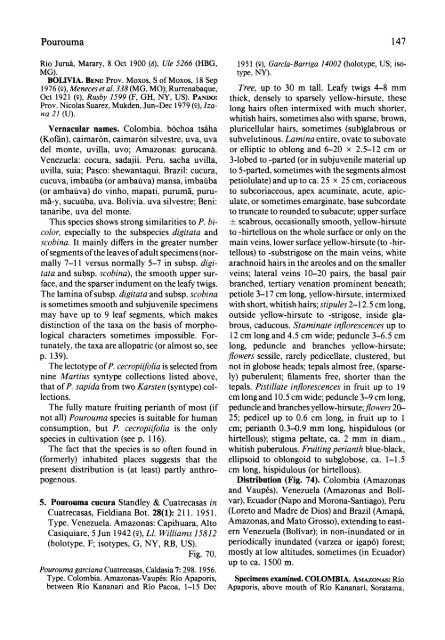Cecropiaceae: Coussapoa and Pourouma, with an ... - CNCFlora
Cecropiaceae: Coussapoa and Pourouma, with an ... - CNCFlora
Cecropiaceae: Coussapoa and Pourouma, with an ... - CNCFlora
You also want an ePaper? Increase the reach of your titles
YUMPU automatically turns print PDFs into web optimized ePapers that Google loves.
<strong>Pourouma</strong> 147<br />
Rio Jurua, Marary, 8 Oct 1900 (c), Ule 5266 (HBG, 1951 (e), Garcia-Barriga 14002 (holotype, US; iso-<br />
MG).<br />
type, NY).<br />
BOLIVIA. BENI: Prov. Moxos, S of Moxos, 18 Sep<br />
1976 (9), Meneces et al. 338 (MG, MO); Rurrenabaque, Tree, up to 30 m tall. Leafy twigs 4-8 mm<br />
Oct 1921 (9), Rusby 1599 (F, GH, NY, US). PANDO: thick, densely to sparsely yellow-hirsute, these<br />
Prov. Nicolas Suarez, Mukden, Jun-Dec 1979 (2), Izawa<br />
21 long hairs often intermixed <strong>with</strong> much shorter,<br />
(U).<br />
whitish hairs, sometimes also <strong>with</strong> sparse, brown,<br />
Vernacular names. Colombia. bochoa tsaha pluricellular hairs, sometimes (sub)glabrous or<br />
(Kof<strong>an</strong>), caimaron, caimaron silvestre, uva, uva subvelutinous. Lamina entire, ovate to subovate<br />
del monte, uvilla, uvo; Amazonas: guruc<strong>an</strong>a. or elliptic to oblong <strong><strong>an</strong>d</strong> 6-20 x 2.5-12 cm or<br />
Venezuela: cocura, sadajii. Peru. sacha uvilla, 3-lobed to -parted (or in subjuvenile material up<br />
uvilla, suia; Pasco: shew<strong>an</strong>taqui. Brazil: cucura, to 5-parted, sometimes <strong>with</strong> the segments almost<br />
cucuva, imbauba (or ambauva) m<strong>an</strong>sa, imbafba petiolulate) <strong><strong>an</strong>d</strong> up to ca. 25 x 25 cm, coriaceous<br />
(or ambauva) do vinho, mapati, puruma, puru- to subcoriaceous, apex acuminate, acute, apicma-y,<br />
sucuuiba, uva. Bolivia. uva silvestre; Beni: ulate, or sometimes emarginate, base subcordate<br />
t<strong>an</strong>aribe, uva del monte.<br />
to truncate to rounded to subacute; upper surface<br />
This species shows strong similarities to P. bi- ? scabrous, occasionally smooth, yellow-hirsute<br />
color, especially to the subspecies digitata <strong><strong>an</strong>d</strong> to -hirtellous on the whole surface or only on the<br />
scobina. It mainly differs in the greater number main veins, lower surface yellow-hirsute (to -hirof<br />
segments of the leaves of adult specimens (nor- tellous) to -substrigose on the main veins, white<br />
mally 7-11 versus normally 5-7 in subsp. digi- arachnoid hairs in the areoles <strong><strong>an</strong>d</strong> on the smaller<br />
tata <strong><strong>an</strong>d</strong> subsp. scobina), the smooth upper sur- veins; lateral veins 10-20 pairs, the basal pair<br />
face, <strong><strong>an</strong>d</strong> the sparser indument on the leafy twigs. br<strong>an</strong>ched, tertiary venation prominent beneath;<br />
The lamina of subsp. digitata <strong><strong>an</strong>d</strong> subsp. scobina petiole 3-17 cm long, yellow-hirsute, intermixed<br />
is sometimes smooth <strong><strong>an</strong>d</strong> subjuvenile specimens <strong>with</strong> short, whitish hairs; stipules 2-12.5 cm long,<br />
may have up to 9 leaf segments, which makes outside yellow-hirsute to -strigose, inside gladistinction<br />
of the taxa on the basis of morpho- brous, caducous. Staminate inflorescences up to<br />
logical characters sometimes impossible. For- 12 cm long <strong><strong>an</strong>d</strong> 4.5 cm wide; peduncle 3-6.5 cm<br />
tunately, the taxa are allopatric (or almost so, see long, peduncle <strong><strong>an</strong>d</strong> br<strong>an</strong>ches yellow-hirsute;<br />
p. 139).<br />
flowers sessile, rarely pedicellate, clustered, but<br />
The lectotype ofP. cecropiifolia is selected from not in globose heads; tepals almost free, (sparsenine<br />
Martius syntype collections listed above, ly) puberulent; filaments free, shorter th<strong>an</strong> the<br />
that of P. sapida from two Karsten (syntype) col- tepals. Pistillate inflorescences in fruit up to 19<br />
lections.<br />
cm long <strong><strong>an</strong>d</strong> 10.5 cm wide; peduncle 3-9 cm long,<br />
The fully mature fruiting peri<strong>an</strong>th of most (if peduncle <strong><strong>an</strong>d</strong> br<strong>an</strong>ches yellow-hirsute;flowers 20not<br />
all) <strong>Pourouma</strong> species is suitable for hum<strong>an</strong> 25; pedicel up to 0.6 cm long, in fruit up to 1<br />
consumption, but P. cecropiifolia is the only cm; peri<strong>an</strong>th 0.3-0.9 mm long, hispidulous (or<br />
species in cultivation (see p. 116).<br />
hirtellous); stigma peltate, ca. 2 mm in diam.,<br />
The fact that the species is so often found in whitish puberulous. Fruiting peri<strong>an</strong>th blue-black,<br />
(formerly) inhabited places suggests that the ellipsoid to oblongoid to subglobose, ca. 1-1.5<br />
present distribution is (at least) partly <strong>an</strong>thro- cm long, hispidulous (or hirtellous).<br />
pogenous.<br />
Distribution (Fig. 74). Colombia (Amazonas<br />
<strong><strong>an</strong>d</strong> Vaupes), Venezuela (Amazonas <strong><strong>an</strong>d</strong> Boli-<br />
5. <strong>Pourouma</strong> cucura St<strong><strong>an</strong>d</strong>ley & Cuatrecasas in var), Ecuador (Napo <strong><strong>an</strong>d</strong> Morona-S<strong>an</strong>tiago), Peru<br />
Cuatrecasas, Fieldi<strong>an</strong>a Bot. 28(1): 211. 1951. (Loreto <strong><strong>an</strong>d</strong> Madre de Dios) <strong><strong>an</strong>d</strong> Brazil (Amapa,<br />
Type. Venezuela. Amazonas: Capihuara, Alto Amazonas, <strong><strong>an</strong>d</strong> Mato Grosso), extending to east-<br />
Casiquiare, 5 Jun 1942 (Q), LI. Williams 15812 ern Venezuela (Bolivar); in non-inundated or in<br />
(holotype, F; isotypes, G, NY, RB, US). periodically inundated (varzea or igap6) forest;<br />
Fig. 70. mostly at low altitudes, sometimes (in Ecuador)<br />
up to ca. 1500 m.<br />
<strong>Pourouma</strong> garci<strong>an</strong>a Cuatrecasas, Caldasia 7:298. 1956.<br />
Type. Colombia. Amazonas-Vaupes: Rio Apaporis, Specimens examined. COLOMBIA. AMAZONAS: Rio<br />
between Rio K<strong>an</strong><strong>an</strong>ari <strong><strong>an</strong>d</strong> Rio Pacoa, 1-15 Dec Apaporis, above mouth of Rio K<strong>an</strong><strong>an</strong>ari, Soratama,
















